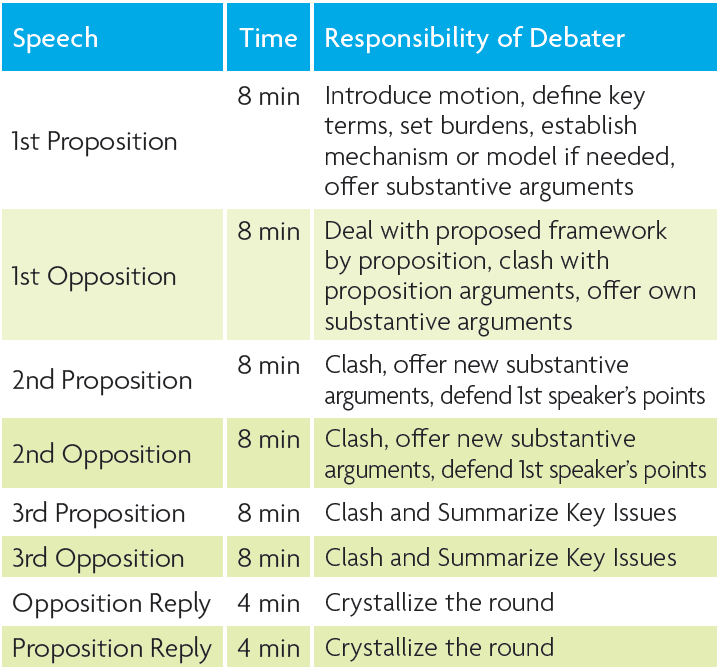How To Judge World Schools Debate
Basic Understanding
World Schools Debate is a unique and dynamic form of debate, unlike any other practiced in the United States. World Schools Debate is a dynamic format combining “prepared” topics with “impromptu” topics, encouraging debaters to focus on specific issues rather than debate theory or procedural arguments. This highly interactive style of debate allows debaters to engage each other, even during speeches. This challenging format requires good teamwork and in-depth quality argumentation.
Getting Started
The judge will fill in the sides and speaker information in the appropriate spaces on the ballot. In order to follow along and evaluate arguments, it is highly recommended that the judge take notes throughout the round. The debate proceeds as follows:

Evaluating the Round
Motions for Worlds Schools Debate are based upon the legislative model. Every motion then begins with the words, “This House”. The debaters are acting as a legislative chamber and debating about what the government would or should do. Motions are debated in a general sense, and are not about extreme or isolated examples. Additionally the debaters ought to imagine that the house is a worldwide governing body that governs all or most of the countries worldwide. Another way of looking at it is that the house represents what each country’s government and/or people would or should do.
The motions debated in World Schools Debate are either motions or propositions of value or policy. A proposition of value will ask debaters to qualify if the topic of the motion is; good or bad, or has done more harm than good, or is better than some other alternative. A policy motion will ask the debaters to create an actual policy that will improve or solve a certain economic, political or social situation given in the motion to be debated. The Proposition team will bring forth a reasonable policy that will solve the problem that is given or being discussed in the motion. The Opposition team can choose to engage with the efficacy of the Proposition team’s “model” or “mechanism” that they’ve given to solve the problem or the Opposition team can offer a solution of their own which they will argue actually solves the problem(s) better than the Proposition team’s mechanism or model.
Finally, the Proposition and Opposition teams should engage with the debate on a principled level and a pragmatic level. The pragmatic level deals with how if we propose or oppose the motion what practical implications will that have in the real world. This is where the use of real world examples plays heavily into the debate. However, in addition to that, the debaters should challenge the assumptions and values of the policies and scenarios that are being discussed in the motion on a principled level.
Filling Out the Ballot
At the end of the debate, the judge will indicate on the ballot which team won the round and assign speaker points. The first three speeches are scored on a scale of 60-80 with the reply speech being scored on a 30-40 point scale. The total number of points for each team is then tallied, and the winning team must have more points than the losing team. Ties and low point wins are not permitted. Please follow the directions on the National Speech & Debate Association ballot for instructions on scoring. Judges will not on the ballot why they voted for one team over the other. The ballot can also provide constructive feedback to both teams.
